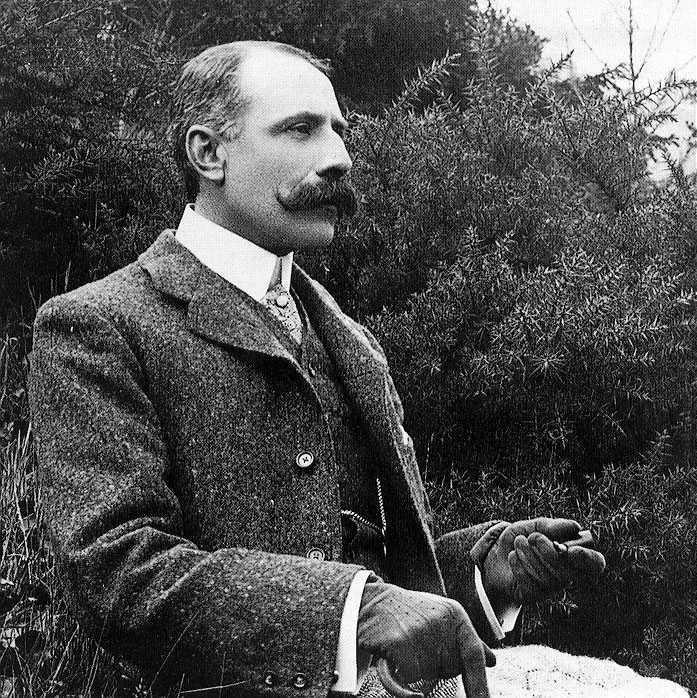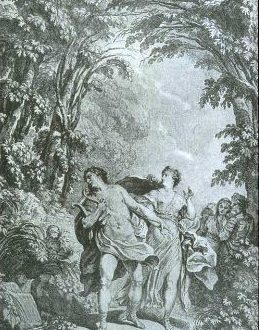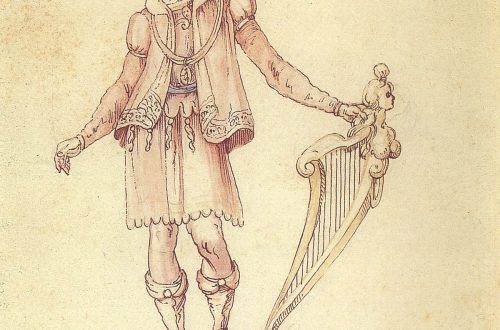
Edward William Elgar |
Edward Elgar
Elgar. Violin Concerto. Allegro (Jascha Heifetz)
Elgar… is in English music what Beethoven is in German music. B. Shaw
E. Elgar – the largest English composer of the turn of the XIX-XX centuries. The formation and flourishing of his activities are closely connected with the period of the highest economic and political power of England during the reign of Queen Victoria. The technical and scientific achievements of English culture and the firmly established bourgeois-democratic freedoms had a fruitful influence on the development of literature and art. But if the national literary school at that time put forward the outstanding figures of C. Dickens, W. Thackeray, T. Hardy, O. Wilde, B. Shaw, then music was just beginning to revive after almost two centuries of silence. Among the first generation of composers of the English Renaissance, the most prominent role belongs to Elgar, whose work vividly reflects the optimism and resilience of the Victorian era. In this he is close to R. Kipling.
Elgar’s homeland is the English province, the neighborhood of the town of Worcester, not far from Birmingham. Having received his first music lessons from his father, an organist and owner of a music shop, Elgar further developed independently, learning the basics of the profession in practice. Only in 1882 did the composer pass the exams at the Royal Academy of Music in London in the violin class and in musical theoretical subjects. Already in childhood, he mastered playing many instruments – violin, piano, in 1885 he replaced his father as a church organist. The English province at that time was the faithful custodian of national musical and, first of all, choral traditions. A huge network of amateur circles and clubs maintained these traditions at a fairly high level. In 1873, Elgar began his professional career as a violinist in the Worcester Glee Club (choral society), and from 1882 he worked in his hometown as an accompanist and conductor of an amateur orchestra. During these years, the composer composed a lot of choral music for amateur groups, piano pieces and chamber ensembles, studied the work of classics and contemporaries, and performed as a pianist and organist. From the end of the 80s. and until 1929, Elgar alternately lives in different cities, including London and Birmingham (where he teaches at the university for 3 years), and completes his life in his homeland – in Worcester.
The significance of Elgar for the history of English music is determined primarily by two compositions: the oratorio The Dream of Gerontius (1900, on the st. J. Newman) and the symphonic Variations on an Enigmatic Theme (Enigma Variations {Enigma (lat.) – a riddle. }, 1899), which became the heights of English musical romanticism. The oratorio “The Dream of Gerontius” sums up not only the long development of cantata-oratorio genres in the work of Elgar himself (4 oratorios, 4 cantatas, 2 odes), but in many respects the entire path of English choral music that preceded it. Another important feature of the national Renaissance was also reflected in the oratorio – an interest in folklore. It is no coincidence that, after listening to “The Dream of Gerontius”, R. Strauss proclaimed a toast “to the prosperity and success of the first English progressive Edward Elgar, the master of the young progressive school of English composers.” Unlike the Enigma oratorio, variations laid the foundation stone for national symphonism, which before Elgar was the most vulnerable area of English musical culture. “Enigma variations testify that in the person of Elgar the country has found an orchestral composer of the first magnitude,” wrote one of the English researchers. The “mystery” of the variations is that the names of the composer’s friends are encrypted in them, and the musical theme of the cycle is also hidden from view. (All this is reminiscent of the “Sphinxes” from “Carnival” by R. Schumann.) Elgar also owns the first English symphony (1908).
Among the composer’s other numerous orchestral works (overtures, suites, concertos, etc.), the Violin Concerto (1910) stands out – one of the most popular compositions of this genre.
Elgar’s work is one of the outstanding phenomena of musical romanticism. Synthesizing national and Western European, mainly Austro-German influences, it bears the features of lyrical-psychological and epic directions. The composer makes extensive use of the system of leitmotifs, in which the influence of R. Wagner and R. Strauss is clearly felt.
Elgar’s music is melodically charming, colorful, has a bright characteristic, in symphonic works it attracts orchestral skill, subtlety of instrumentation, manifestation of romantic thinking. By the beginning of the XX century. Elgar rose to European prominence.
Among the performers of his compositions were outstanding musicians – conductor H. Richter, violinists F. Kreisler and I. Menuhin. Often speaking abroad, the composer himself stood at the conductor’s stand. In Russia, Elgar’s works were approved by N. Rimsky-Korsakov and A. Glazunov.
After the creation of the Violin Concerto, the composer’s work gradually declined, only in the last years of his life did his activity revive. He writes a number of compositions for wind instruments, sketches the Third Symphony, the Piano Concerto, the opera The Spanish Lady. Elgar survived his glory, at the end of his life his name became a legend, a living symbol and pride of English musical culture.
G. Zhdanova





